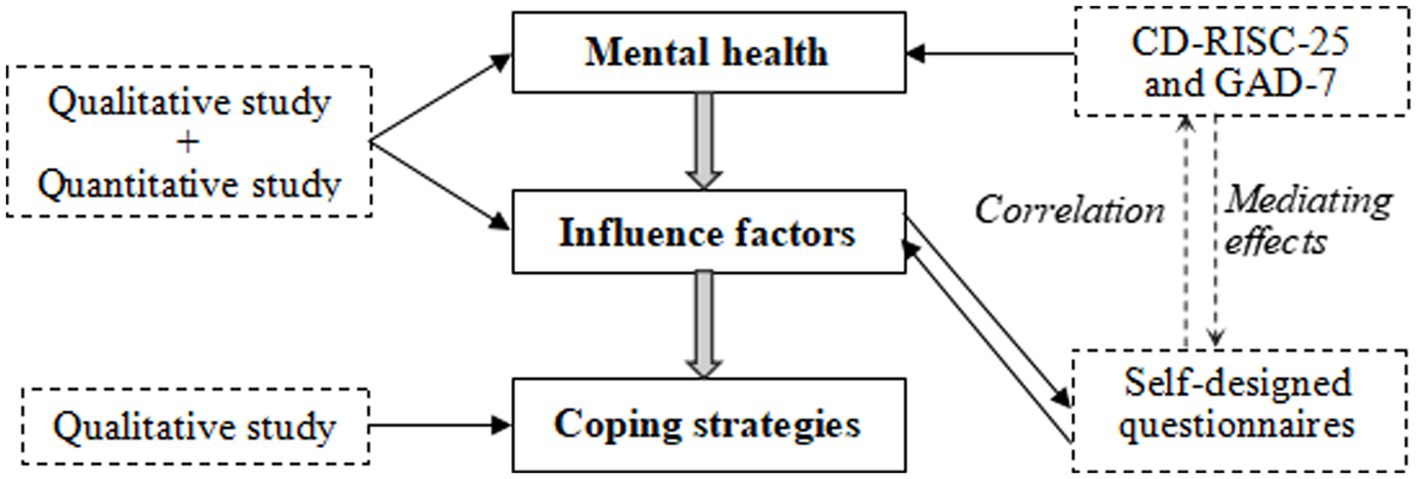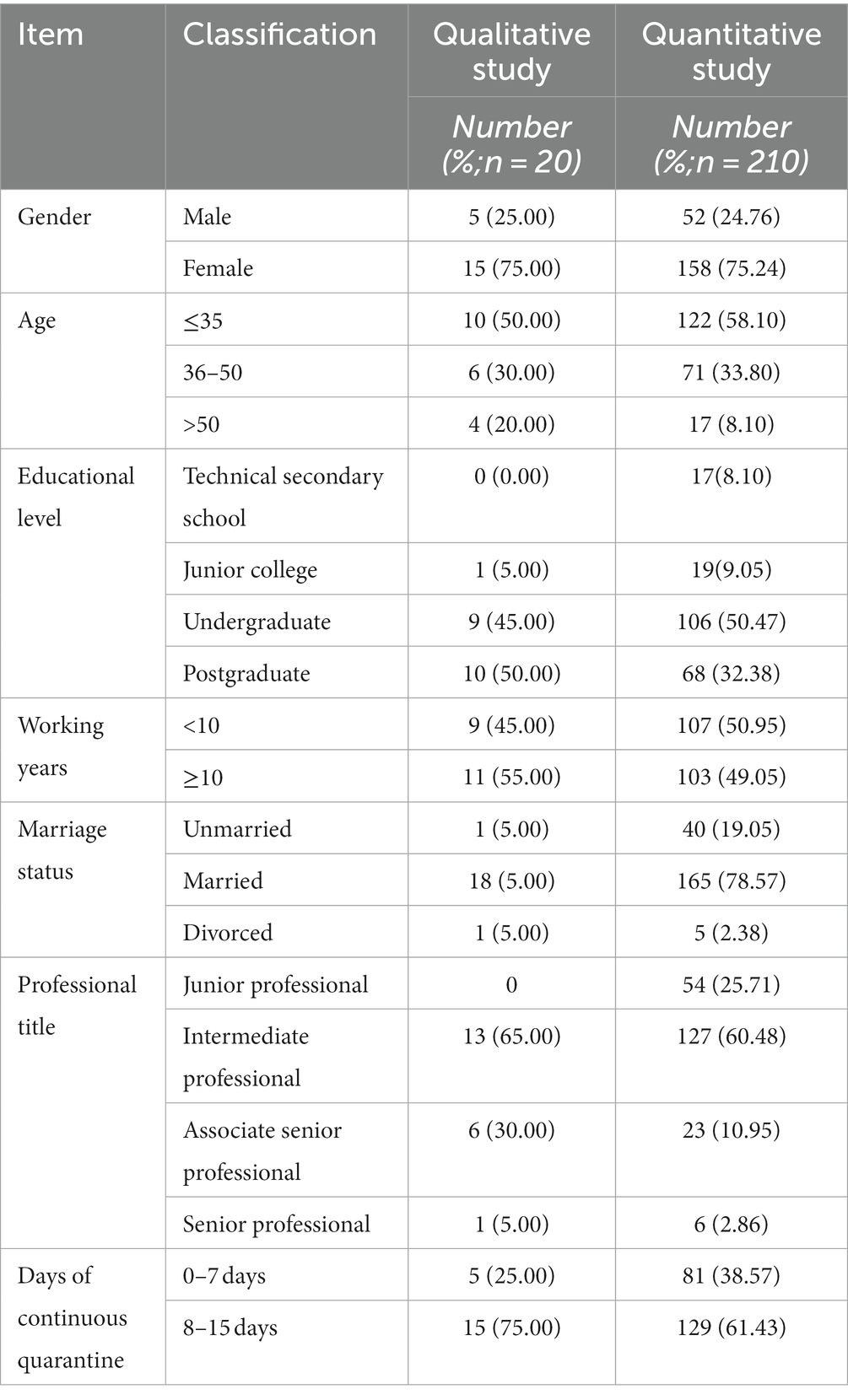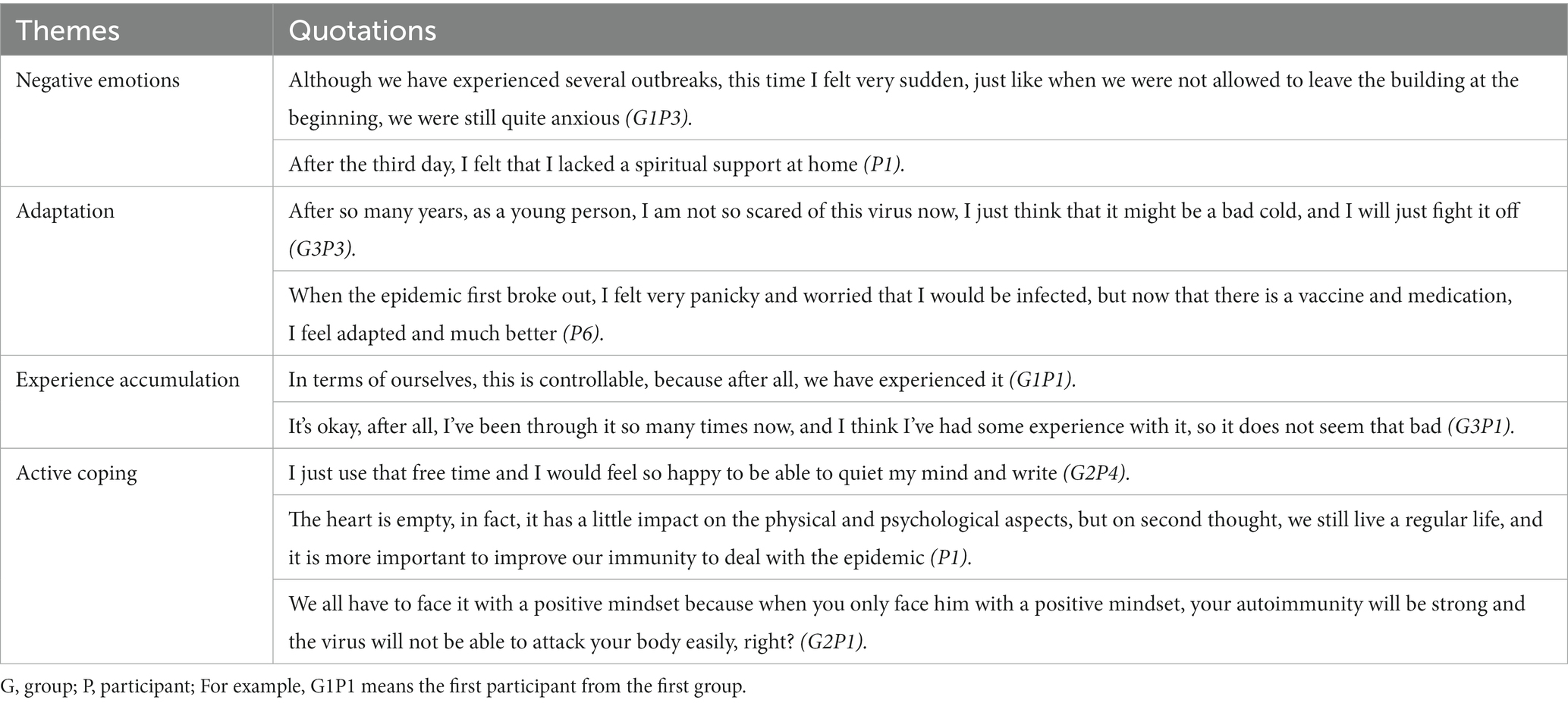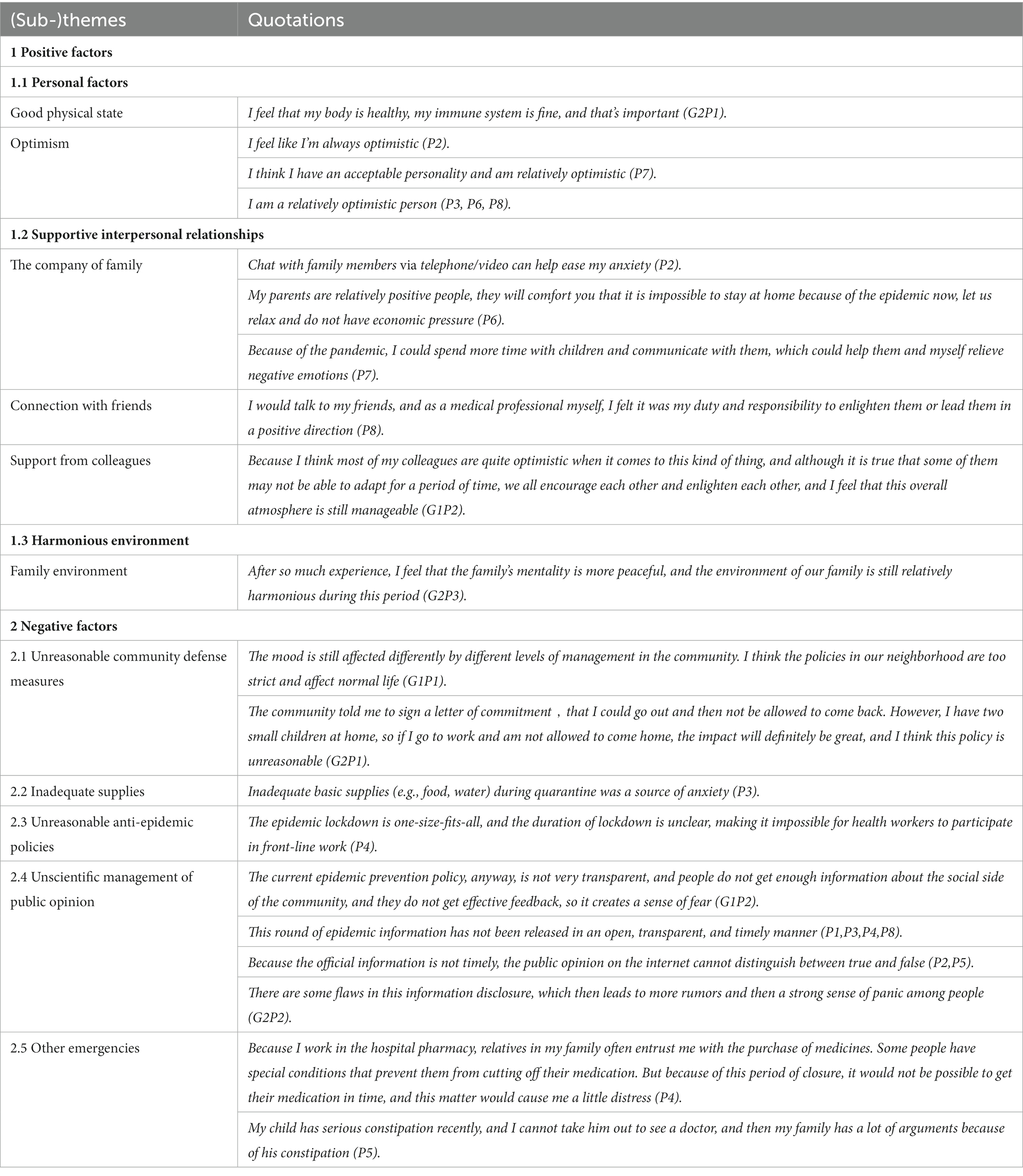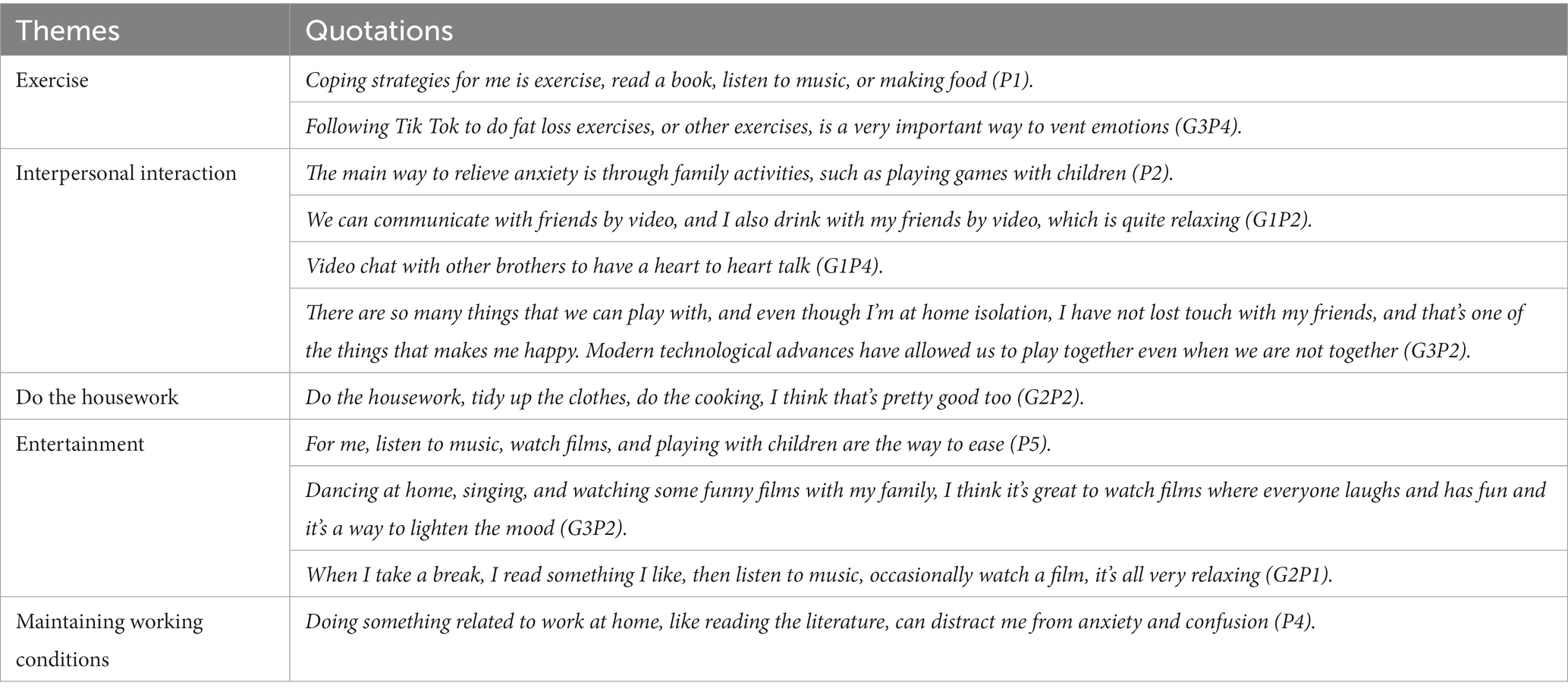- 1Institute for Hospital Management of Henan Province, Zhengzhou, China
- 2Department of Pharmacy, The First Affiliated Hospital of Zhengzhou University, Zhengzhou, China
- 3Beijing Chaoyang Hospital, Party Committee Office, Beijing, China
- 4Henan Drug Clinical Comprehensive Evaluation Center, Zhengzhou, China
Objective: There is a notable research gap on the mental health challenges faced by hospital pharmacists in the post-pandemic era. Therefore, the present study aims to explore mental health status, influencing factors, coping strategies, and the mediating effect of resilience of home quarantine hospital pharmacists (HQHPs).
Methods: An embedded mixed-method study was conducted in Zhengzhou, a megalopolis in central China, from 20 October to 3 November 2022. For the qualitative study, semi-structured interviews and focus group discussions were conducted among HQHPs to understand their mental health state,the factors that affect their mental health, and the alleviating strategies they used. For the quantitative study, the Generalized Anxiety Disorder Scale (GAD-7) and the Chinese version of the Connor-Davidson Resilience Scale (CD-RISC-25) were used to explore the mental health level of HQHPs. Meanwhile, the mediating effect of resilience was explored and verified with the bootstrap method or the structural equation model.
Results: 20 HQHPs participated in the qualitative study. Two themes were identified in terms of the factors that influenced the HQHPs’ mental health levels. The positive factors include optimism, family company, and connection with friends, while the negative factors include inadequate supplies, inadequate information, and other emergencies. 210 HQHPs participated in the quantitative study, with a median resilience score of 66 [55.75, 74] in the lowest score range and an anxiety score of 5 [2, 7] in the mild anxiety range. The correlation analysis showed that nine of the 10 influencing factors identified in qualitative research were positively correlated with CD-RISC-25 scores and negatively correlated with the GAD-7 score. The mediating effect of resilience on anxiety was significant (95% bootstrap CI [−1.818, −0.384], p<0.001; or 95% bootstrap CI [−1.174, −0.430], p<0.001).
Conclusion: Even in the post-epidemic era, hospital pharmacists face psychological challenges. They actively address these issues based on accumulated experience and a stabilized mindset. In this process, resilience plays a significant mediating role.
Introduction
Coronavirus Disease 2019 (COVID-19) has left an indelible mark on community life, healthcare, and education (1, 2). Governments worldwide have responded with myriad measures, ranging from city lockdowns to social isolation, quarantines for infected populations, and home isolation (3). In particular, individuals working in healthcare settings, particularly hospital pharmacists and other healthcare workers (HCWs), are disproportionately susceptible to mental health challenges during this unprecedented crisis. China, being the first nation to face the challenges posed by COVID-19, implemented stringent quarantine measures to curb the spread of the virus within its borders and in other regions (4). After years of battling the COVID-19 virus and its variants, China’s domestic epidemic prevention and control program transitioned to a normalized stage in 2022. Despite this progress, local and sporadic virus outbreaks have recently emerged in specific regions and cities (5). An illustrative case is the recent COVID-19 outbreak in Zhengzhou, the capital of central China’s Henan Province, disrupted work for all practitioners. These individuals were compelled to stay home due to temporary lockdowns and controlled zones designed to stem the virus’s spread. This situation stands out as uncommon on a global scale, where many regions have eased their epidemic containment measures. However, despite the worldwide impact of such extreme conditions, research on the specific consequences for the mental health of pharmacists remains relatively limited.
Quarantine has been shown to significantly reduce mental health levels (6–8). Brooks et al. (9) reviewed the psychological impact of quarantine and isolation and found negative psychological effects, including post-traumatic stress symptoms, confusion, insomnia, avoidance behaviors and confusion, highlighting the importance of reducing quarantine to a minimally required period of time. In the battle against COVID-19, pharmacists have become a crucial component of the healthcare system. Their contributions include formulating professional service guidelines for pharmacists and pharmacies, creating emergency drug lists, addressing and monitoring drug shortages, offering telemedicine services, conducting public education on infection prevention and disease management, as well as actively participating in clinical trials and drug evaluations (10, 11). However, compared to nursing staff and physicians, the psychological challenges associated with COVID-19 for hospital pharmacists have received relatively less attention (12). Studies performed prior to the COVID-19 outbreak have shown that pharmacists have a lower health-related quality of life and higher levels of anxiety than the general population and other health professionals, including physicians, nurses, and others (13, 14).
Anxiety is a prominent marker in researching the psychological well-being of HCWs during the COVID-19 pandemic for several key reasons. First, studies report that more than 25% of HCWs, particularly medical personnel, experience anxiety at significant levels (15). Second, anxiety reflects an emotional response that includes concerns, tension, and fear regarding potential threats, which makes it crucial to capture the emotional state of HCWs navigating stress and uncertainty (16). Third, the levels of anxiety in HCWs can affect their focus on patient safety and job performance, contributing to a better understanding of their professional responsibilities during epidemic responses (17). Last, anxiety is commonly associated with stressful events. Given the global impact of the COVID-19 pandemic, it serves as a critical marker for characterizing mental health levels in studying the psychological issues of healthcare professionals post-quarantine in the epidemic’s aftermath.
Dealing with special situations arising from the epidemic, such as quarantine, is an essential concern in the post-epidemic era. Previous studies have reported a variety of coping strategies, such as establishing harmonious interpersonal relationships, building a good community environment, and creating a good climate of public opinion (18). These external pillars have played an instrumental role in surmounting adversities amidst the pandemic (19). In addition, personal factors such as a positive mindset, optimism, and inner drive are also important, with resilience being one of the individual inner drives that have been particularly highlighted in previous reports (16). Resilience, a critical concept in positive psychology, is the personal ability to cope with or overcome various perceived adversities and stress. Individuals with higher levels of resilience work through challenges using personal resources, strengths, and other positive psychological capital capacities, such as hope, optimism, and self-efficacy, to “bounce back” as a stronger person than before (20). Previous research has shown that physicians’ and nurses’ stress mindset and resilience could mitigate the negative outcomes of COVID-19 health anxiety by helping them view this stressful situation more positively and consider it a challenge rather than a threat (21). Hence, we seek to employ psychological resilience as a mediating variable to explain the possible intrinsic regulatory determinants that affect the response of HQHPs to anxiety.
Despite extensive research on healthcare workers’ coping strategies, a significant research gap exists in understanding how HQHPs cope, particularly in the post-epidemic era. Examining the entire COVID-19 timeline, healthcare workers face distinct challenges requiring nuanced coping strategies from the pandemic through the transition period to the post-epidemic era. During the pandemic, prioritizing teamwork, providing practical support tools, and ensuring comprehensive pharmacist training are crucial to managing daily high-intensity pressure and fatigue (22–24). In the transition period, in addition to adaptation training and mental health support, open communication and self-management are vital to adapting to a new workplace and promoting mental well-being (25). In the post-epidemic era, healthcare workers may experience fatigue and emotional stress, requiring mental health support services, such as professional consultations and participation in support groups, along with promoting adequate rest and recovery time (26). For HQHPs in mainland China during the post-epidemic era, despite the lenient global epidemic prevention policies, they are obligated to undergo home isolation, leading to increased mental stress, physical stress, and increased work burden (26). Consequently, the mental health challenges faced by hospital pharmacists in mainland China during home isolation require urgent attention and investigation (27).
Study aims
Given the unique circumstances outlined above, there is a critical need to understand the mental health status of HQHPs, identify influencing factors, explore coping strategies, and uncover potential intrinsic regulatory factors. In response to these considerations, this study focuses on anxiety as the outcome variable linked to mental health levels, with resilience serving as a mediator. The research aims to accomplish the following objectives: (1) clarify the current psychological well-being of HQHPs during home quarantine in the post-epidemic era; (2) analyze potential factors affecting the mental health levels of HQHPs, emphasizing the mediating role of psychological resilience; and (3) investigate potential strategies employed by HQHPs in addressing mental health issues.
Methods
Study design
Previous research in this field mainly relied on cross-sectional quantitative studies or qualitative investigations through in-depth interviews. While each method has strengths and limitations, our study employs a mixed-method embedded research design to explore mental health among HQHPs (28). This design seamlessly integrates both qualitative and quantitative methodologies, allowing for a comprehensive examination of the research question. By synthesizing data from these two approaches, we aim to capture information on multiple levels and dimensions, enriching our understanding of the research phenomenon. An advantageous aspect of this approach is the mutual validation between qualitative and quantitative components (29).
To achieve our research objectives, we followed the procedural steps outlined in mixed-method embedded research (30). First, we used qualitative research to gain an in-depth understanding of the psychological experience of quarantined hospital pharmacists and the multidimensional factors influencing their mental health in this exceptional situation, as well as to summarize their coping strategies. Second, a quantitative study was performed to validate the factors identified during the qualitative study and analyzed the mediating role of resilience. Finally, the results of the qualitative and quantitative studies were integrated. The detailed flow chart of the study is presented in Figure 1.
Settings and participants
HQHPs (20 October to 30 November 2022) were selected from several large hospitals in Henan province. These sample hospitals included the First Affiliated Hospital of Zhengzhou University, the Second Affiliated Hospital of Zhengzhou University, the Third Affiliated Hospital of Zhengzhou University, the 7th People’s Hospital of Zhengzhou, Henan Children’s Hospital, Henan Provincial Cancer Hospital, and Henan Coking Coal Central Hospital. With a combined capacity of 20,700 beds and approximately 730 pharmacists, these traditional large tertiary hospitals ranked among the best in central China (31). The inclusion criteria for the participants were (1) volunteered to participate in this study, (2) worked a minimum of 1 year in the department of pharmacy in the sample hospitals, and (3) had experienced quarantine between 20 October and 3 November 2022.
This study used a census approach, sampling all eligible HQHPs from the sample hospitals. The researcher communicated with the pharmacy department leaders in the sample hospitals to discuss the research objectives and plans. Subsequently, all eligible HQHPs were recruited by the pharmacy department leaders in their respective institutions. Finally, 240 pharmacists participated in this study, including clinical pharmacists, dispensing pharmacists, managers, information pharmacists, etc. A total of 240 questionnaires were sent, and 210 valid questionnaires were recovered (87.50%). Of the 210 participants in the quantitative study, 20 volunteered to participate in a qualitative interview study. Eight pharmacists participated in the one-on-one interview and 12 participated in focus group discussions (four in each group). Participant flow is shown in Supplementary Figure S1, and the demographic characteristics of all the participants are shown in Table 1.
Instruments
Resilience
The Chinese version of the Connor-Davidson Resilience Scale (CD-RISC-25) (20, 32), was used to evaluate individual resilience. This valid and reliable scale (Cronbach’s alpha = 0.963) comprises 25 items rated on a five-point Likert scale from 0 (not true at all) to 4 (true all the time). The total score ranges from 0 to 100, with a higher score indicating greater resilience. The scores for the lowest quartile range from 0 to 73, the second lowest quartile scores range from 74 to 82, the third quartile scores range from 83 to 90, and the fourth quartile scores range from 91 to 100 (33).
Anxiety
Anxiety levels were assessed using the 7-item Generalized Anxiety Disorder Scale (GAD-7), a well-validated tool with high reliability (Cronbach’s alpha = 0.929). This instrument aggregates responses from seven questions designed to screen and diagnose generalized anxiety disorder (34). The respondents provide 4-point responses, ranging from 0 (not at all) to 3 (nearly every day), both in clinical practice and research. The cumulative scores, ranging from 0 to 21, are categorized as follows: normal (0–4), mild (5–9), moderate (10–14), and severe (15–21) anxiety. Participants with a total GAD-7 score ≥ 10 are identified as positive for anxiety screening (35).
Self-designed questionnaire
In the absence of available standardized questionnaires, a self-designed questionnaire was developed comprising 10 questions, guided by the influencing factors identified in the preliminary findings of the qualitative study (Supplementary Table S1). The self-designed questionnaire demonstrated satisfactory internal consistency, with Cronbach’s alpha at 0.839. To ensure the clarity and completeness of the questions, a pilot study was conducted involving 20 HQHPs. The questionnaire was evaluated based on feedback received. After incorporating the suggestions provided by the participating HQHPs and making the necessary adjustments, the primary research was initiated.
Data collection and analysis
Qualitative study
For the qualitative survey, purposeful sampling was used to obtain participants from the HQHPs involved in the quantitative research. Due to the restrictions of the COVID-19 pandemic, all interviews were conducted by phone calls or video chat. After informed consent, semi-structured interviews or focus group discussions were led by one researcher (ZY) and recorded by another (XJL or XYW). An interview topic guide (Supplementary Table S2, designed by ZY and XJL before the interview) was piloted in an interview. Data saturation was reached after interviewing 8 HQHPs and three focus group discussions. All interviews took place from 20 October to 3 November 2022. Data saturation was defined as “no new themes or codes emerge from interviews.”
The interview data were analyzed using a thematic analysis approach, a method to identify, analyze, and report patterns within the data widely used in qualitative research. The key steps include familiarization with the data, generating initial codes, searching and reviewing the themes, naming the themes, and producing the final report (36). Within 24 h after the interview, the interview data were transcribed verbatim by one researcher (ZY) and checked by two other researchers (XJL and XYW). After confirming that the transcriptions were correct, two researchers (ZY and XJL) independently completed the extraction of the codes and wrote the first draft of the themes and subthemes. Subsequently, the research group discussed the first draft and proposed comments and suggestions for theme structure and language expression. Under the guidance of a senior research expert, the research team compared and analyzed discrepancies and established the final themes and subthemes. The final draft were developed with the agreement of the research group, and appropriate representative quotes were selected to present the themes or subthemes. NVivo12 software was used to manage and analyze the data in the process described above. This study followed the Consolidated Criteria for Reporting Qualitative Research (COREQ) checklist (Supplementary Table S3) (37).
Quantitative study
For the quantitative study, the responses to the online survey were exported from Questionnaire Star to an Excel file (Excel version 2016; Microsoft Corp., Redmond, WA, United States). Data were cleaned, coded, and analyzed using IBM SPSS® (Armonk, NY, United States) statistical software version 26. Measurement data are expressed as median with [25% lower quartile; 75% upper quartile], and count data are expressed as percentages. Each participant’s total score for CD-RISC-25 and GAD-7 was calculated by summing the individual item scores. The Shapiro–Wilk test was used to assess data normality. Independent sample t-test or one-way ANOVA was used to examine differences in CD-RISC-25 and GAD-7 among demographic variables following a normal distribution. The Mann–Whitney U test or Kruskal-Wallis test was used for variables that do not satisfy the assumption of homogeneity of variance. The 10 self-designed questions, anxiety, and resilience scores exhibited a non-normal distribution, as indicated by the Shapiro–Wilk test (p < 0.05). Additionally, the corresponding Cronbach’s α coefficients were calculated. Spearman’s correlation analysis was used to evaluate the relationships among the self-designed questions, resilience, and anxiety.
Using the bootstrap-mediated effects test, we hypothesized that resilience mediated between self-imposed questions and anxiety. Therefore, the non-parametric percentile bootstrap method was used to test the mediating effect of resilience between self-designed questions and anxiety (N = 5,000) (24, 25). The mediating effect analysis aims to determine the presence of a mediating effect and identify the corresponding parameter type. The significance of the parameter refers to the value of the influence effect. A mediating effect is considered statistically significant when the 95% confidence interval of bootstrap does not include 0 (38). A mediated effect path analysis diagram was produced using Amos 23.0 modeling and analysis. All statistical tests were two-tailed, and p-values < 0.05 were considered statistically significant.
Trustworthiness
We took measures to ensure the credibility of this study, as elaborated in our previous research. These measures included (1) the research team comprised individuals with expertise in conducting mixed-methods, qualitative, or quantitative studies; (2) the principal investigator remained in frequent communication with methodological experts to address challenges in the research process continually; (3) participants validated the findings upon analyzing qualitative data to ensure consistency; and (4) the study adhered strictly to operational procedures throughout its execution.
Results
Demographic characteristics
The qualitative study had 20 participants with an average age of 34.47 ± 7.47 years, 75% women, and an average work experience of 9.73 ± 8.85 years. The quantitative study had 210 participants with a mean age of 36.62 ± 8.24 years, 75.24% female, and a mean work experience of 13.55 ± 9.55 years. Demographic data are shown in Table 1.
Qualitative results
The qualitative study results were divided into three parts: pharmacist psychological status under quarantine, factors influencing pharmacist psychological status, and countermeasures against negative psychological states under quarantine.
Psychological states of pharmacists under quarantine
The psychological state of the HQHPs under quarantine was identified (Table 2). The participants stated that compared to late 2019, HQHPs had gradually adapted to the impact of the epidemic and quarantine, and their mentality was more stable. However, there were still various factors that caused negative emotions, such as anxiety. After 3 years of the epidemic, HQHPs had gained a lot of experience that could help them to alleviate negative emotions. In the quarantined situation, some participants also mentioned that they reflected on life and felt that the value of life had been sublimated.
Multidimensional factors affecting the psychological state of HQHPs
Two main themes were identified regarding the factors influencing the HQHPs’ mental health (Table 3). Among them, positive factors include (1) personal factors, such as good physical state and optimism; (2) supportive interpersonal relationships, such as family companion, connection with friends, and colleague support; and (3) harmonious environment, for example, a family environment. The negative factors include: (1) community defense measures deemed unreasonable, (2) insufficient supplies, (3) anti-epidemic policies perceived as inadequate, (4) unscientific management of public opinion, including opaque information and low credibility of self-media, and (5) other unforeseen emergencies.
Strategies for coping with psychological problems under quarantine
The strategies to cope with psychological problems fell into five broad categories (Table 4). Most of the participants highlighted exercise, such as yoga, as a stress-relief method. Interacting with family or friends was also cited as a mood-enhancing activity. The participation in simple household tasks such as cooking, in addition to participating in personal favorite recreational activities such as watching movies or listening to music, were identified as effective coping strategies. Lastly, involving oneself in work-related tasks to maintain a productive state was mentioned as a means to alleviate negative emotions.
Quantitative results
In the quantitative part of the study, we implemented a 10-item additional survey based on the qualitative research that defined the role of personal factors, interpersonal relationships, the surrounding environment, community management, epidemic prevention policies, and public opinion management in influencing HQHPs’ mental health (Figure 2). We also used GAD-7 and CD-RISC by a web-based questionnaire to investigate the mental health status of hospital pharmacists. Cronbach’s alpha indicates relatively high internal reliability for the three parts of the questionnaire (Cronbach’s α = 0.839 for the 10 self-designed questions, α = 0.963 for the Chinese version of CD-RISC-25, and α = 0.929 for GAD-7), indicating good reliability of questionnaires in quantitative studies.
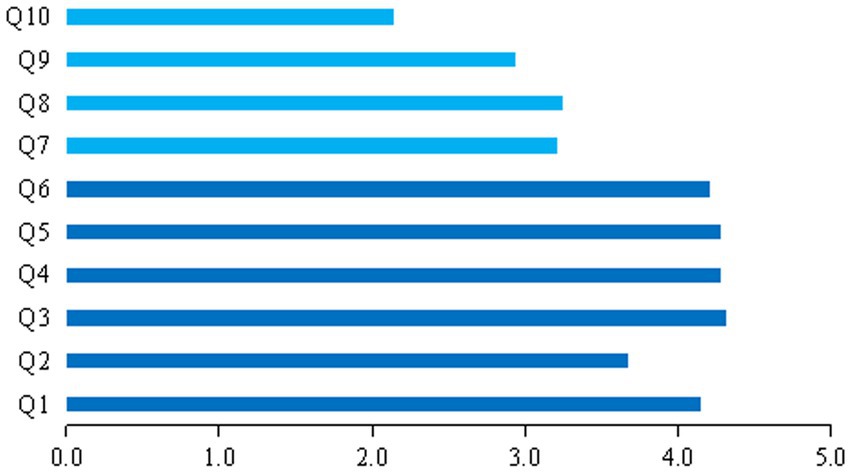
Figure 2. Evaluation of HQHPs on impact factors. Q1: I think my body state enough to deal with in the past few days; Q2: I think I’m naturally optimistic; Q3: I feel very supported by my family; Q4: I think my friends are very supportive; Q5: I get along well with my coworkers; Q6: I think my family environment is very harmonious; Q7: I think the epidemic prevention management in the community is very scientific; Q8: I think the epidemic prevention and control policies are very scientific; Q9: I think the public opinions on epidemic prevention and control are full of positive energy; Q10: I have a stronger religious faith.
We used the Kaiser-Meyer-Olkin (KMO) index to determine if the data were suitable for factor analysis (26). The value of KMO was 0.839, which is above the threshold of 0.7. To facilitate subsequent studies, we conducted an exploratory factor analysis (EFA) on the 10 self-designed questions. EFA revealed two factors with a cumulative explained variance of 65.896%, where Q1-Q6 had higher scores, and this higher level of agreement represents a positive personal state or surrounding environment, thus defining them as positive factors. Whereas, Q7–Q10 had relatively lower scores and lower levels of agreement showed a negative external environment, thus defining them as negative factors (Supplementary Table S4).
Mental health status of HQHPs
CD-RISC-25 scores for HQHPs ranged from 23 to 100, with a median score of 66 [55.75, 74], which is in the range of low resilience. As shown in Supplementary Table S5, the resilience was significantly higher in the male group than in the female group (p = 0.006). There were no significant differences in other demographic variables. In terms of anxiety, the median GAD-7 score was 5 [2, 7], which is on the mild anxiety level. There were no significant differences in anxiety scores between all demographic variables.
HQHPs’ evaluation of impact factors
The findings indicated that 80% of HQHPs affirmed being in good physical condition and sufficiently resilient at the physiological level to cope with the impacts of epidemic containment. A substantial majority (80% or more) of HQHPs reported having a harmonious family living environment supported by family members, friends, and colleagues. However, only 46.34% expressed strong optimism, 21.14% did not consider themselves naturally optimistic, and 32.52% had reservations. Furthermore, the HQHPs expressed concerns about the perceived lack of preventive and control measures at the scientific level and deemed government-level prevention and control policies unreasonable. The management of public opinion at the social level could have been more transparent, with only 38.57%, 45.70%, and 27.62% of the respondents agreeing with the reasonableness of these three aspects, respectively. In particular, a small percentage of HQHPs (7.53%) reported having strong religious beliefs. Detailed quantitative findings are presented in Figure 2.
Correlation analysis of self-designed questions, resilience, and anxiety
The Shapiro–Wilk test showed that the data conform to nonnormality. Spearman’s correlation analysis showed that positive factors (Q1–Q6) and negative factors (Q7–Q10) were all positively correlated with CD-RISC-25 scores and negatively correlated with the GAD-7 score. There was a significant negative correlation between resilience and anxiety (Spearman correlation r = −0.451, p < 0.001; Supplementary Table S6).
The mediating effect of psychological resilience
Following mediating effects analysis, for positive factors (Q1–Q6), the total and indirect effects on anxiety were significant (p < 0.01), with a mediating effect confidence interval of [−1.818, −0.384] (Table 5). The indirect impact accounted for 39.01%, indicating partial mediation by resilience. Similarly, for negative factors (Q7–Q10), total and indirect effects on anxiety were significant (p < 0.01), with a mediating effect confidence interval of [−1.174, −0.430] (Table 6). Resilience played a partial mediating role, representing 82.87% of the total effect, while the direct effect of negative factors on anxiety was non-significant (p > 0.05).
Amos was used to construct a structural equation model, with resilience serving as a mediator variable (Figure 3). Regarding positive factors (Q1–Q6), the results indicated that the path coefficients in the model were statistically significant (p < 0.01), and the fit indices for the structural equation model were as follows: CMIN/DF = 3.524, RMSEA = 0.110. Specifically, Q7–Q10 demonstrated a positive impact on resilience (β = 0.58, p < 0.01), while resilience showed a negative effect on anxiety (β = −0.32, p < 0.01). Concerning negative factors, the path coefficient of the model was also statistically significant (p < 0.01), and the fit indices were deemed acceptable: CMIN/DF = 2.111, RMSEA = 0.073. In particular, Q7–Q10 showed a positive influence on resilience (β = 0.47, p < 0.01), and resilience had a negative effect on anxiety (β = −0.39, p < 0.01).
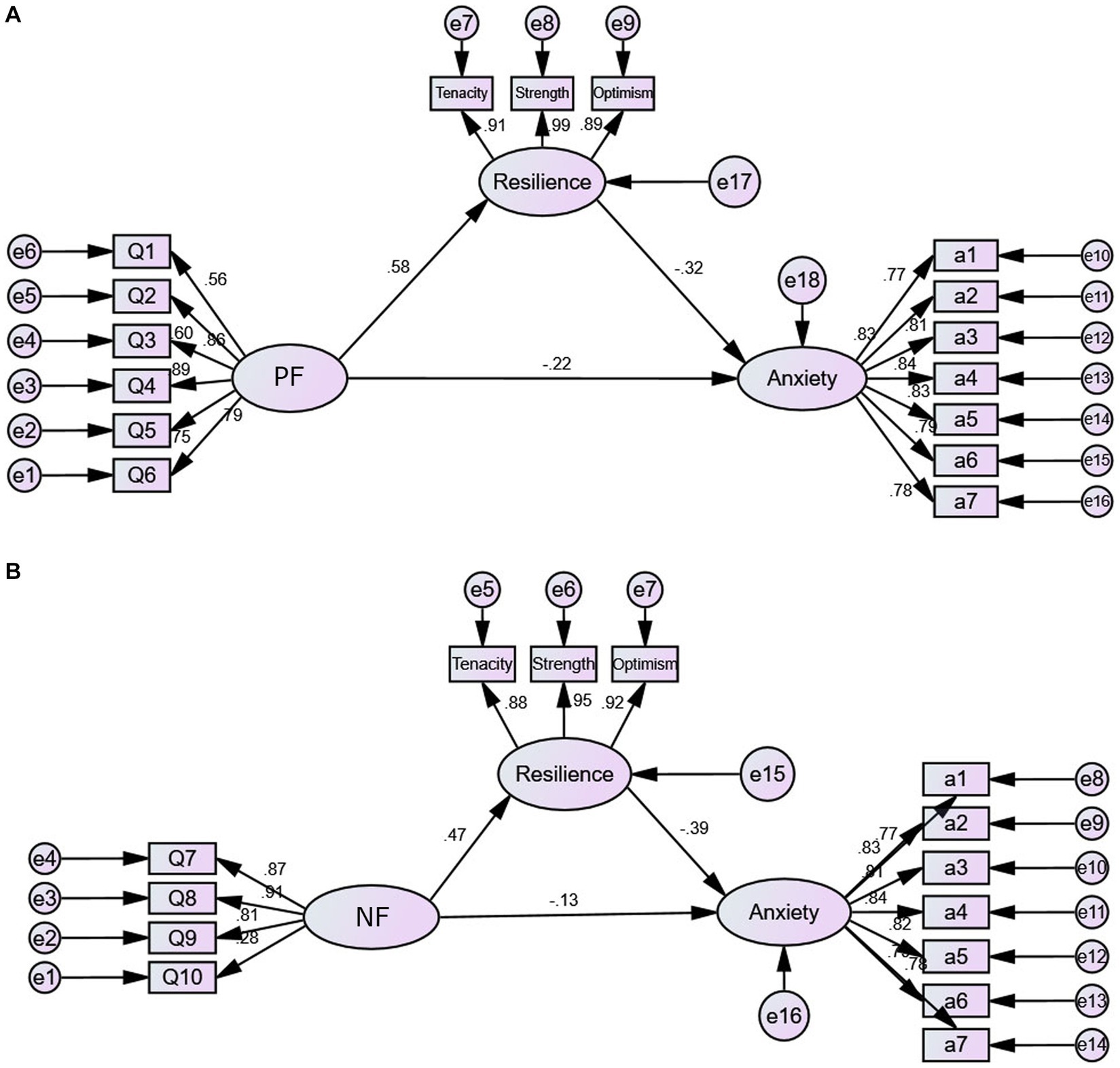
Figure 3. A mediating model of resilience between positive factors (A), negative factors (B) and anxiety. PF, Positive factors; NF, Negative factors.
Discussion
This study is one of the few mixed-method investigations to examine the mental health challenges faced by HQHPs in the later stages of the COVID-19 pandemic. The unique circumstances encountered by the participants can be attributed to several factors: (1) they remained under home quarantine for up to 2 weeks even after quarantine measures were lifted globally; (2) the study city, Zhengzhou, being a megacity, faced challenges in the supply of essential living materials during the quarantine period (27, 39); (3) unlike prior quarantines where medical personnel, including hospital pharmacists, were allowed to move freely with work permits, this time they were subjected to strict restrictions; and (4) despite the crucial role pharmacists play in epidemic prevention and control, their contributions were occasionally overlooked (13). Consequently, we believe that the findings of this study contribute valuable information to a broader understanding of the mental health of medical staff in the context of pandemics like COVID-19.
The qualitative research findings shed light on the impact of home isolation on the mental well-being of hospital pharmacists and offer an initial exploration of the coping measures they employ. The factors influencing home quarantine on the mental health of HQHPs were identified and categorized into positive and negative factors. The positive factors were optimism, family companionship, and connections with friends. These findings are consistent with existing research, highlighting the role of personal resources such as optimism, prosocial behavior, and resilience in effectively mitigating the adverse consequences of the pandemic on mental health (40–42). In addition, the importance of family companionship and connections with friends in alleviating mental stress has also been affirmed in other studies (43, 44).
Negative factors include insufficient supplies, inadequate information, and other emergent situations. The substantial impact of scarce basic supplies on psychological distress has been well-documented in previous studies (45). In response, relevant government departments must ensure that quarantined households have ample supplies to meet basic needs, delivered promptly, and ideally coordinated in advance with conservation and redistribution plans to prevent resource depletion.
Since the onset of COVID-19, there has been increased demand and attention for pandemic-related information. Information reception generally falls into two categories: official and unofficial sources. Official sources involve government disclosures and expert voices in medical and other fields. Unofficial sources include Internet users’ opinions, gossip, and conversations with family and friends, both online (e.g., WeChat, phone calls) and offline (face-to-face). In this study, numerous participants indicated dissatisfaction with the official release of information, causing a reliance on social media for information, which may contain misinformation and disinformation detrimental to physical and mental health. In line with WHO recommendations, member states should develop action plans to manage the infodemic by promoting the timely dissemination of accurate information based on science and evidence, particularly to high-risk groups, while combating misinformation and respecting freedom of expression (46). HQHPs in quarantine may also be concerned about staff shortages that cause additional work for colleagues. Other emergencies, such as difficulty accessing regular medical care and prescriptions, emerged as challenges for some participants.
In the second stage, GAD-7 and CD-RISC-25 were used to assess the mental health levels (anxiety and resilience) of HQHPs. The results revealed that the HQHPs exhibited mild anxiety levels and resilience scores within the range of low resilience. In particular, at the time of the study, the epidemic had persisted for nearly 3 years. On the one hand, the public’s attitude toward the epidemic had evolved from initial panic and anxiety to adaptation and acceptance, resulting in generally mild anxiety levels among HQHPs (47). However, multiple sporadic cases and local outbreaks, coupled with uncertainty about when the outbreak would end, contributed to a reduction in the psychological resilience of the public (40). At this stage, we explored the correlations between the influencing factors identified in the first stage and the levels of resilience and anxiety. The results confirmed that, except for religious belief, the other factors were positively and negatively correlated with resilience and anxiety, respectively. These findings have significant value in preventing and reducing psychological issues among pharmacists.
This study has several strengths and weaknesses. Strengths include enhancing knowledge of hospital pharmacists’ psychological state post-epidemic, a specific and representative target population and scenario, and using an embedded mixed methods approach for robust results. However, weaknesses include a relatively small quantitative sample size, a need for in-depth exploration of resilience mediating effects, a limited geographic scope to one province in central China, and the potential for subjective biases in data interpretation. Researchers should exercise caution, ensuring transparency in their methodology to mitigate these limitations.
Conclusion
Our study reveals significant correlations between the psychological resilience and anxiety of HQHPs and their traits, the micro-environment of survival, and the macro-environment. Except for religious beliefs, all first-stage influencing factors are positively correlated with CD-RISC-25 and negatively correlated with GAD-7. This underscores the importance of maintaining positive relationships with family and friends during home sequestration in the face of public health emergencies. Furthermore, our research explores coping strategies used by HQHPs to alleviate anxiety during stay-at-home conditions, such as exercise, yoga, watching films, listening to music, cooking, and playing with children. These findings offer insight into safeguarding the psychological well-being of healthcare workers in future public health emergencies.
Data availability statement
The raw data supporting the conclusions of this article will be made available by the authors, without undue reservation.
Ethics statement
Ethics was approved by the First Affiliated Hospital of Zhengzhou University Institutional Review Board (No. 2022-KY-0736). The studies were conducted in accordance with the local legislation and institutional requirements. Written informed consent for participation in this study was provided by the participants' legal guardians/next of kin.
Author contributions
ZY: Investigation, Methodology, Writing – original draft, Writing – review & editing. XW: Data curation, Investigation, Writing – original draft. XL: Data curation, Investigation, Writing – original draft. HF: Funding acquisition, Methodology, Writing – review & editing.
Funding
The author(s) declare financial support was received for the research, authorship, and/or publication of this article. The work was supported by Young Science Foundation of the National Natural Science Foundation of China (72004207).
Acknowledgments
The authors acknowledge the support of all interviewees who participated in the study.
Conflict of interest
The authors declare that the research was conducted in the absence of any commercial or financial relationships that could be construed as a potential conflict of interest.
Publisher’s note
All claims expressed in this article are solely those of the authors and do not necessarily represent those of their affiliated organizations, or those of the publisher, the editors and the reviewers. Any product that may be evaluated in this article, or claim that may be made by its manufacturer, is not guaranteed or endorsed by the publisher.
Supplementary material
The Supplementary material for this article can be found online at: https://www.frontiersin.org/articles/10.3389/fpubh.2024.1268638/full#supplementary-material
References
1. Costenoble, A, De Baets, S, Knoop, V, Debain, A, Bautmans, I, Verté, D, et al. The impact of covid-19 lockdown on the quality of life, meaningful activities, and frailty in community-dwelling octogenarians: a study in Belgium. Aging Ment Health. (2023) 27:1567–75. doi: 10.1080/13607863.2022.2145457
2. Ye, Z, Yang, X, Zeng, C, Wang, Y, Shen, Z, Li, X, et al. Resilience, social support, and coping as mediators between COVID-19-related stressful experiences and acute stress disorder among college students in China. Appl Psychol Health Well Being. (2020) 12:1074–94. doi: 10.1111/aphw.12211
3. Du, Z, Pandey, A, Bai, Y, Fitzpatrick, MC, Chinazzi, M, Pastore, YPA, et al. Comparative cost-effectiveness of SARS-CoV-2 testing strategies in the USA: a modelling study. Lancet Public Health. (2021) 6:e184–91. doi: 10.1016/S2468-2667(21)00002-5
4. Gao, J, and Zhang, P. China's public health policies in response to COVID-19: from an "authoritarian" perspective. Front Public Health. (2021) 9:756677. doi: 10.3389/fpubh.2021.756677
5. Wang, J, and Wang, Z. Strengths, weaknesses, opportunities and threats (SWOT) analysis of China's prevention and control strategy for the COVID-19 epidemic. Int J Environ Res Public Health. (2020) 17:2235. doi: 10.3390/ijerph17072235
6. Daly, M, Sutin, AR, and Robinson, E. Longitudinal changes in mental health and the COVID-19 pandemic: evidence from the UK household longitudinal study. Psychol Med. (2022) 52:2549–58. doi: 10.1017/S0033291720004432
7. Fancourt, D, Steptoe, A, and Bu, F. Trajectories of anxiety and depressive symptoms during enforced isolation due to COVID-19 in England: a longitudinal observational study. Lancet Psychiatry. (2021) 8:141–9. doi: 10.1016/S2215-0366(20)30482-X
8. Wang, C, Pan, R, Wan, X, Tan, Y, Xu, L, McIntyre, RS, et al. A longitudinal study on the mental health of general population during the COVID-19 epidemic in China. Brain Behav Immun. (2020) 87:40–8. doi: 10.1016/j.bbi.2020.04.028
9. Brooks, SK, Webster, RK, Smith, LE, Woodland, L, Wessely, S, Greenberg, N, et al. The psychological impact of quarantine and how to reduce it: rapid review of the evidence. Lancet. (2020) 395:912–20. doi: 10.1016/S0140-6736(20)30460-8
10. Liu, S, Luo, P, Tang, M, Hu, Q, Polidoro, JP, Sun, S, et al. Providing pharmacy services during the coronavirus pandemic. Int J Clin Pharm. (2020) 42:299–304. doi: 10.1007/s11096-020-01017-0
11. Bukhari, N, Rasheed, H, Nayyer, B, and Babar, ZU. Pharmacists at the frontline beating the COVID-19 pandemic. J Pharmaceut Policy Practice. (2020) 13:8. doi: 10.1186/s40545-020-00210-w
12. Safwan, J, Halat, DH, Akel, M, Younes, S, Rahal, M, Mourad, N, et al. The impact of COVID-19 on the mental health of Lebanese pharmacists: a national cross-sectional study. Front Public Health. (2023) 11:1156840. doi: 10.3389/fpubh.2023.1156840
13. Marshall, LL, Allison, A, Nykamp, D, and Lanke, S. Perceived stress and quality of life among doctor of pharmacy students. Am J Pharm Educ. (2008) 72:137. doi: 10.5688/aj7206137
14. Henning, K, Ey, S, and Shaw, D. Perfectionism, the imposter phenomenon and psychological adjustment in medical, dental, nursing and pharmacy students. Med Educ. (1998) 32:456–64. doi: 10.1046/j.1365-2923.1998.00234.x
15. Hosseinifard, H, Tajik, F, Masoumi, M, Raoofi, N, Ahmadi, S, Aghalou, S, et al. Anxiety during the COVID-19 pandemic in hospital staff: systematic review plus meta-analysis. BMJ Support Palliat Care. (2023) 13:127–35. doi: 10.1136/bmjspcare-2021-003125
16. Hamm, AO . Fear, anxiety, and their disorders from the perspective of psychophysiology. Psychophysiology. (2020) 57:e13474. doi: 10.1111/psyp.13474
17. Nowrouzi-Kia, B, Sithamparanathan, G, Nadesar, N, Gohar, B, and Ott, M. Factors associated with work performance and mental health of healthcare workers during pandemics: a systematic review and meta-analysis. J Public Health. (2022) 44:731–9. doi: 10.1093/pubmed/fdab173
18. Jiang, L, Alizadeh, F, and Cui, W. Effectiveness of Drama-based intervention in improving mental health and well-being: A systematic review and Meta-analysis during the COVID-19 pandemic and post-pandemic period. Healthcare. (2023) 11:839. doi: 10.3390/healthcare11060839
19. Zivot, C, Dewey, C, Brockington, M, Nwebube, C, Asfour, G, Vattikonda, N, et al. Experiences of wellbeing and resilience among refugee mothers and families in Calgary during the COVID-19 pandemic, and the role of participation in HIPPY, a home visiting program. AIMS Public Health. (2022) 9:521–41. doi: 10.3934/publichealth.2022036
20. Connor, KM, and Davidson, JR. Development of a new resilience scale: the Connor-Davidson resilience scale (CD-RISC). Depress Anxiety. (2003) 18:76–82. doi: 10.1002/da.10113
21. Emirza, S, and Yılmaz Kozcu, G. Protecting healthcare workers' mental health against COVID-19-related stress: the effects of stress mindset and psychological resilience. Nurs Health Sci. (2023) 25:216–30. doi: 10.1111/nhs.13018
22. Wang, M, Yin, Z, Zhang, W, Jia, X, Du, S, Li, J, et al. Exploring the Pharmaceutical Care of Pharmacists in China during COVID-19-a National Multicenter Qualitative Study. Front Public Health. (2021) 9:797070. doi: 10.3389/fpubh.2021.797070
23. Hao, J, Wang, X, Jia, X, Yang, Y, Du, S, and Yin, Z. Qualitative research on the work experience of pharmacists in fever clinics and isolation wards of designated hospitals for novel coronavirus pneumonia (COVID-19). BMJ Open. (2021) 11:e048466. doi: 10.1136/bmjopen-2020-048466
24. Yin, Z, Zhang, W, Jia, X, Wang, X, Hao, J, Yang, Y, et al. Psychological distress of frontline HCWsin the intensive care unit during the early stage of the COVID-19 pandemic: a qualitative study from China. BMJ Open. (2022) 12:e049627. doi: 10.1136/bmjopen-2021-049627
25. Maideen, AA, Idris, DR, Lupat, A, Chung, YF, Haji-Badarudin, HS, Suhai, HK, et al. Nurses' mental health and coping strategies throughout COVID-19 outbreak: a nationwide qualitative study. Int J Ment Health Nurs. (2022) 31:1213–27. doi: 10.1111/inm.13031
26. Tang, P, and Lee, M. Exploring the necessity of psychological rounds and psychological interventions in general hospitals in the post-COVID-19 period. Front Psychol. (2022) 13:916776. doi: 10.3389/fpsyg.2022.916776
27. Qiu, L, Li, C, He, W, Yin, X, Zhan, L, Zhang, J, et al. Changes in diet, exercise and psychology of the quarantined population during the COVID-19 outbreak in Shanghai. PLoS One. (2023) 18:e0284799. doi: 10.1371/journal.pone.0284799
28. Creswell, JW, Fetters, MD, and Ivankova, NV. Designing a mixed methods study in primary care. Ann Fam Med. (2004) 2:7–12. doi: 10.1370/afm.104
29. Halcomb, E., and Hickman, L., Mixed methods research. Nursing Standard Royal College of Nursing (Great Britain): (1987) 29 41–47.
30. Ross, R, Sawatphanit, W, Suwansujarid, T, Stidham, AW, Drew, BL, and Creswell, JW. The effect of telephone support on depressive symptoms among HIV-infected pregnant women in Thailand: an embedded mixed methods study. J Assoc Nurses AIDS Care. (2013) 24:e13–24. doi: 10.1016/j.jana.2012.08.005
31. Yao, X, Jia, X, Shi, X, Liu, G, Li, Y, Zhang, X, et al. Exploring the experiences and expectations of pharmacist interns in large general hospitals in China: from the perspective of interns. BMC Med Educ. (2022) 22:528. doi: 10.1186/s12909-022-03591-5
32. Wu, L, Tan, Y, and Liu, Y. Factor structure and psychometric evaluation of the Connor-Davidson resilience scale in a new employee population of China. BMC Psychiatry. (2017) 17:49. doi: 10.1186/s12888-017-1219-0
33. Hamadeh Kerbage, S, Garvey, L, Willetts, G, and Olasoji, M. Undergraduate nursing students' resilience, challenges, and supports during corona virus pandemic. Int J Ment Health Nurs. (2021) 30:1407–16. doi: 10.1111/inm.12896
34. Kroenke, K, Theobald, D, Wu, J, Norton, K, Morrison, G, Carpenter, J, et al. Effect of telecare management on pain and depression in patients with cancer: a randomized trial. JAMA. (2010) 304:163–71. doi: 10.1001/jama.2010.944
35. Spitzer, RL, Kroenke, K, Williams, JB, and Löwe, B. A brief measure for assessing generalized anxiety disorder: the GAD-7. Arch Intern Med. (2006) 166:1092–7. doi: 10.1001/archinte.166.10.1092
36. Vaismoradi, M, Turunen, H, and Bondas, T. Content analysis and thematic analysis: implications for conducting a qualitative descriptive study. Nurs Health Sci. (2013) 15:398–405. doi: 10.1111/nhs.12048
37. Tong, A, Sainsbury, P, and Craig, J. Consolidated criteria for reporting qualitative research (COREQ): a 32-item checklist for interviews and focus groups. Int J Qual Health Care. (2007) 19:349–57. doi: 10.1093/intqhc/mzm042
38. Shrout, PE, and Bolger, N. Mediation in experimental and nonexperimental studies: new procedures and recommendations. Psychol Methods. (2002) 7:422–45. doi: 10.1037/1082-989X.7.4.422
39. Barman, A, Das, R, and De, PK. Logistics and supply chain management of food industry during COVID-19: disruptions and a recovery plan. Environ Syst Decis. (2022) 42:338–49. doi: 10.1007/s10669-021-09836-w
40. Akdağ, B, Ege, D, Göksülük, D, İpekten, F, Erdoğan, A, and Önder, A. The parental COVID-19 anxiety and emotional exhaustion in healthcare workers: exploring the roles of resilience, prosocialness, and optimism. Curr Psychol. (2023) 23:1–10. doi: 10.1007/s12144-023-04414-6
41. Fowler, JB, Fiani, B, Kiessling, JW, Khan, YR, Li, C, Quadri, SA, et al. The correlation of burnout and optimism among medical residents. Cureus. (2020) 12:e 6860. doi: 10.7759/cureus.6860
42. Zhai, S, Wang, P, Wang, A, Dong, Q, Cai, J, and Coyte, PC. A study on satisfaction with publicly financed health services in China. Glob Health. (2017) 13:67. doi: 10.1186/s12992-017-0292-y
43. Salami, B, Yaskina, M, Hegadoren, K, Diaz, E, Meherali, S, Rammohan, A, et al. Migration and social determinants of mental health: results from the Canadian health measures survey. Can J Public Health. (2017) 108:e362–7. doi: 10.17269/cjph.108.6105
44. Smyth, N, Siriwardhana, C, Hotopf, M, and Hatch, SL. Social networks, social support and psychiatric symptoms: social determinants and associations within a multicultural community population. Soc Psychiatry Psychiatr Epidemiol. (2015) 50:1111–20. doi: 10.1007/s00127-014-0943-8
45. Chen, X, Zou, Y, and Gao, H. Role of neighborhood social support in stress coping and psychological wellbeing during the COVID-19 pandemic: evidence from Hubei, China. Health Place. (2021) 69:102532. doi: 10.1016/j.healthplace.2021.102532
46. World Health Organization Managing the COVID-19 infodemic: Promoting healthy behaviours and mitigating the harm from misinformation and disinformation. (2020) Available at: https://www.who.int/news/item/23-09-2020-managing-the-covid-19-infodemic-promoting-healthy-behaviours-and-mitigating-harm-from-misinformation-and-disinformation.
Keywords: home quarantine hospital pharmacists (HQHPs), COVID-19, embedded mixed methods, resilience, mediating effect, mental health
Citation: Yin Z, Wang X, Lu X and Fu H (2024) Hospital pharmacists’ mental health during home isolation in the post-pandemic era of COVID-19: influencing factors, coping strategies, and the mediating effect of resilience. Front. Public Health. 12:1268638. doi: 10.3389/fpubh.2024.1268638
Edited by:
Erum Rehman, Nazarbayev University, KazakhstanReviewed by:
Eszter Eniko Marschalko, Babeș-Bolyai University, RomaniaShusen Sun, Western New England University, United States
Copyright © 2024 Yin, Wang, Lu and Fu. This is an open-access article distributed under the terms of the Creative Commons Attribution License (CC BY). The use, distribution or reproduction in other forums is permitted, provided the original author(s) and the copyright owner(s) are credited and that the original publication in this journal is cited, in accordance with accepted academic practice. No use, distribution or reproduction is permitted which does not comply with these terms.
*Correspondence: Hang Fu, dG9uZ2ppZmhAMTYzLmNvbQ==
†These authors have contributed equally to this work and share first authorship
 Zhao Yin
Zhao Yin XiangYu Wang3†
XiangYu Wang3† Xiaojing Lu
Xiaojing Lu